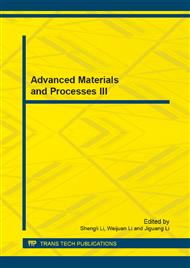p.41
p.47
p.51
p.55
p.60
p.64
p.68
p.72
p.76
Optimization of Bubble Amount in Resin Mineral Composite Based Vacuum Pouring Procedure
Abstract:
With good vibration alleviating property, resin mineral composite has been used to produce main components of machine tools to satisfy the requirements of machining efficiency. Bubble in RMC is one of the key influences on compression strength, its amount and distribution determines the overall mechanical properties of the composite directly. In this article, bubble nucleation and free energy theory are used to explain the generation mechanism of bubbles by subdividing them into two parts, bubbles generated in granite and bubbles generated in resin. Mechanical model of single raised bubble in micro cylinder channel is established based on the flow characteristics of non-newtonian fluid. In order to validate the aforementioned assumptions, typical RMC samples are produced. Strength test and draining method are used to get their compression strength and bulk density. Experimental results show that sample with vacuum pouring process has smaller bubble amount and better compression strength performance, which is consistent with the mechanical model.
Info:
Periodical:
Pages:
60-63
Citation:
Online since:
September 2013
Authors:
Price:
Сopyright:
© 2013 Trans Tech Publications Ltd. All Rights Reserved
Share:
Citation:


